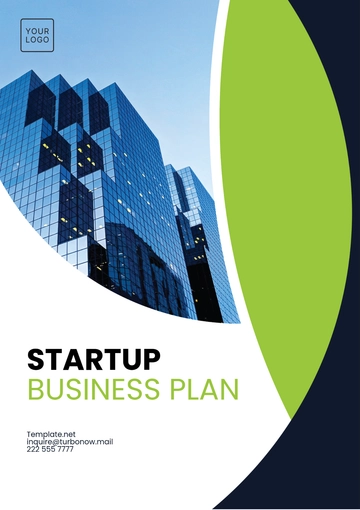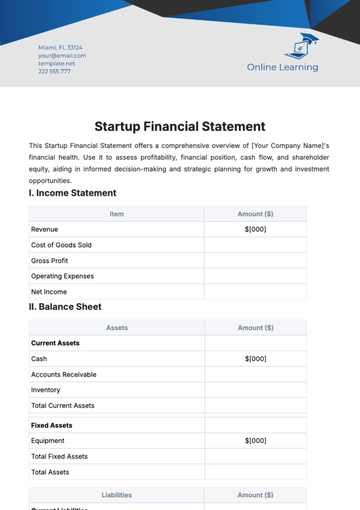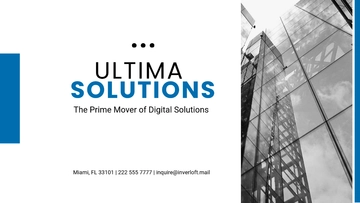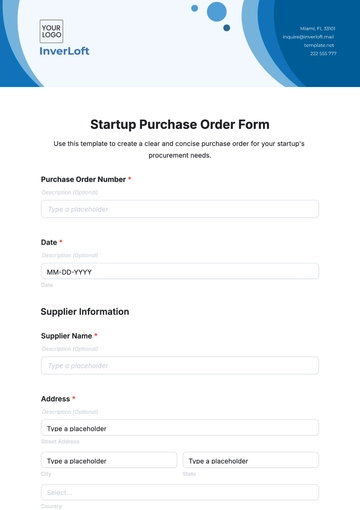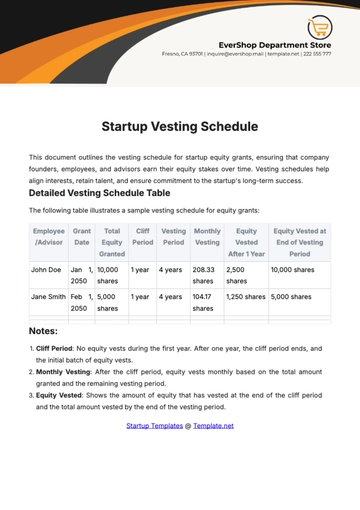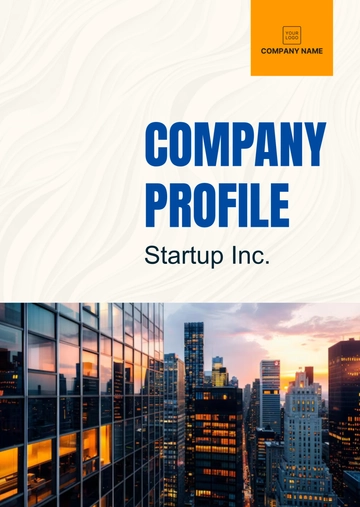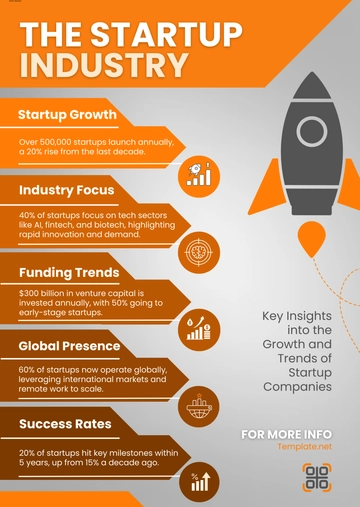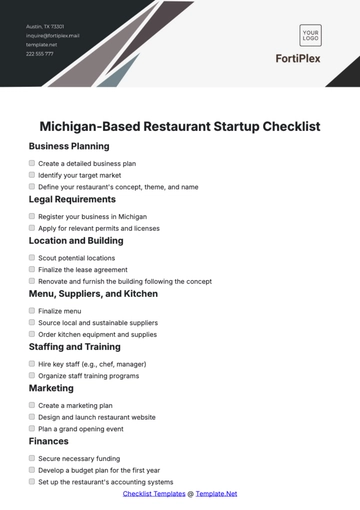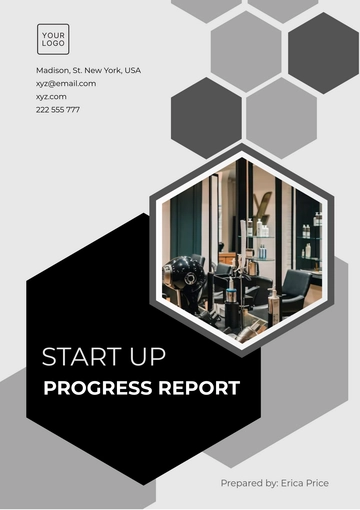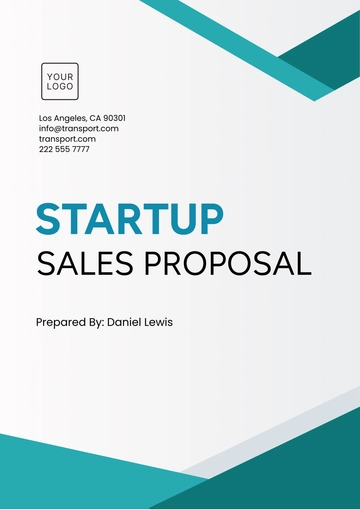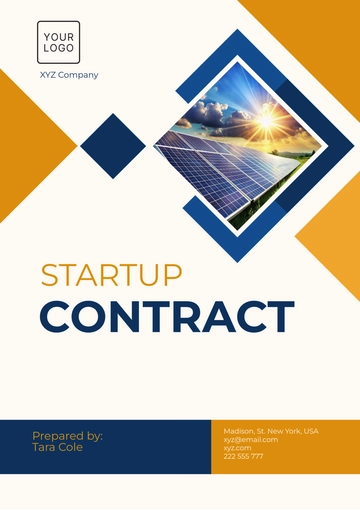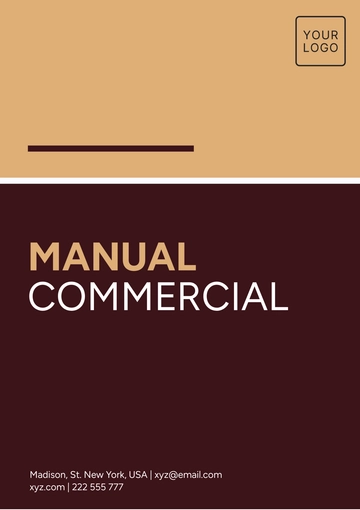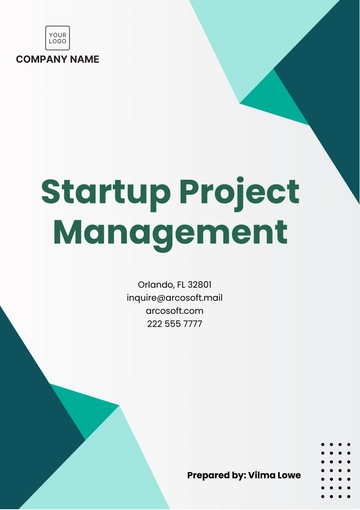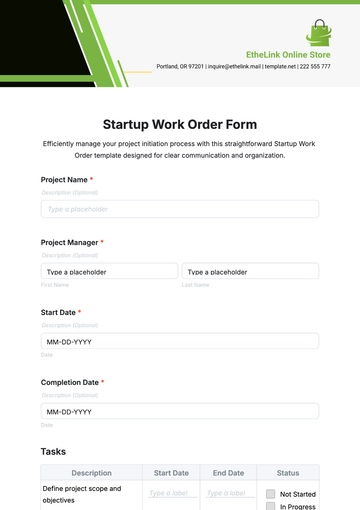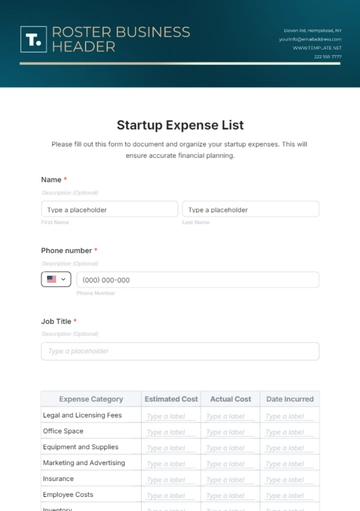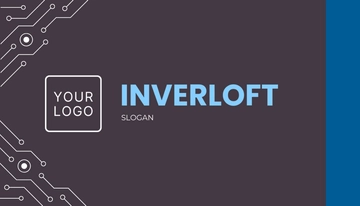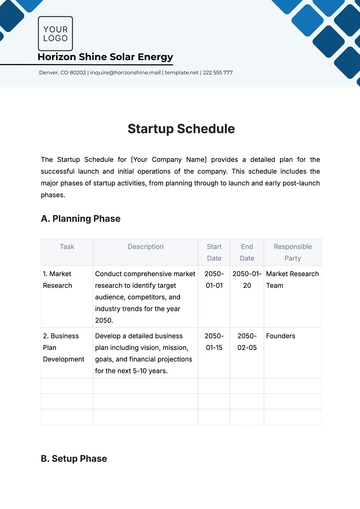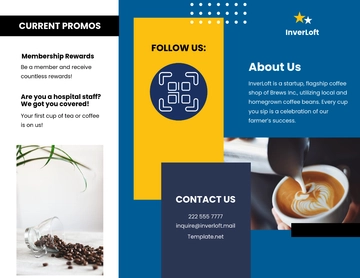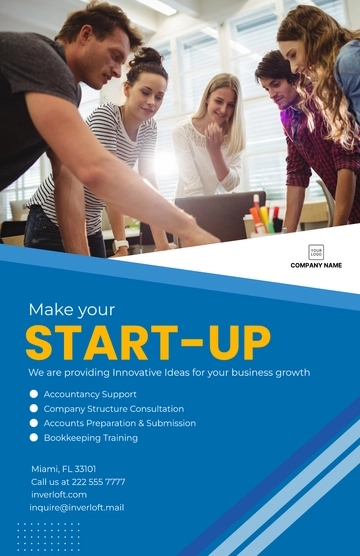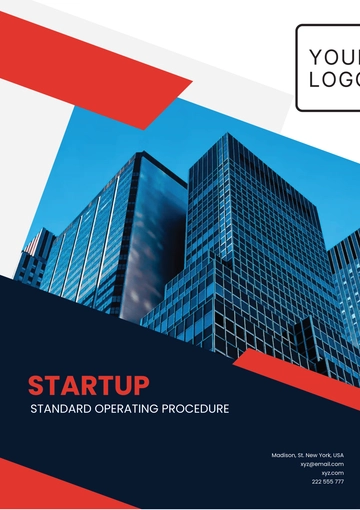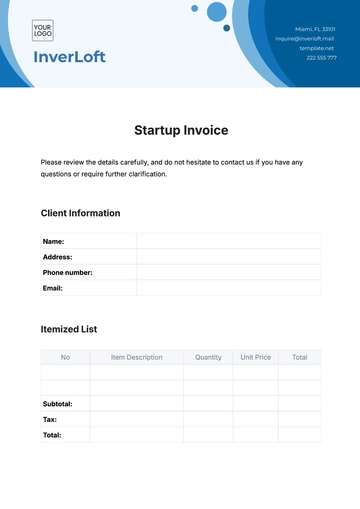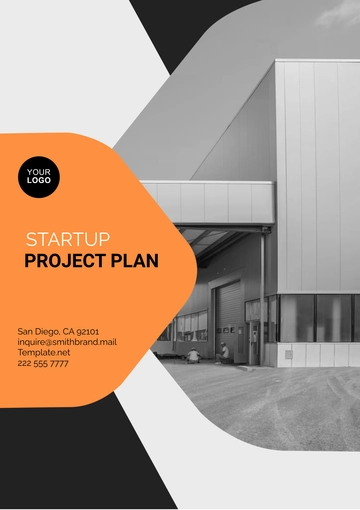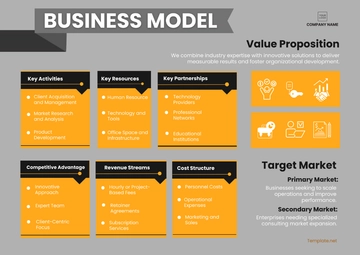Free Startup Workforce Planning and Development Guide
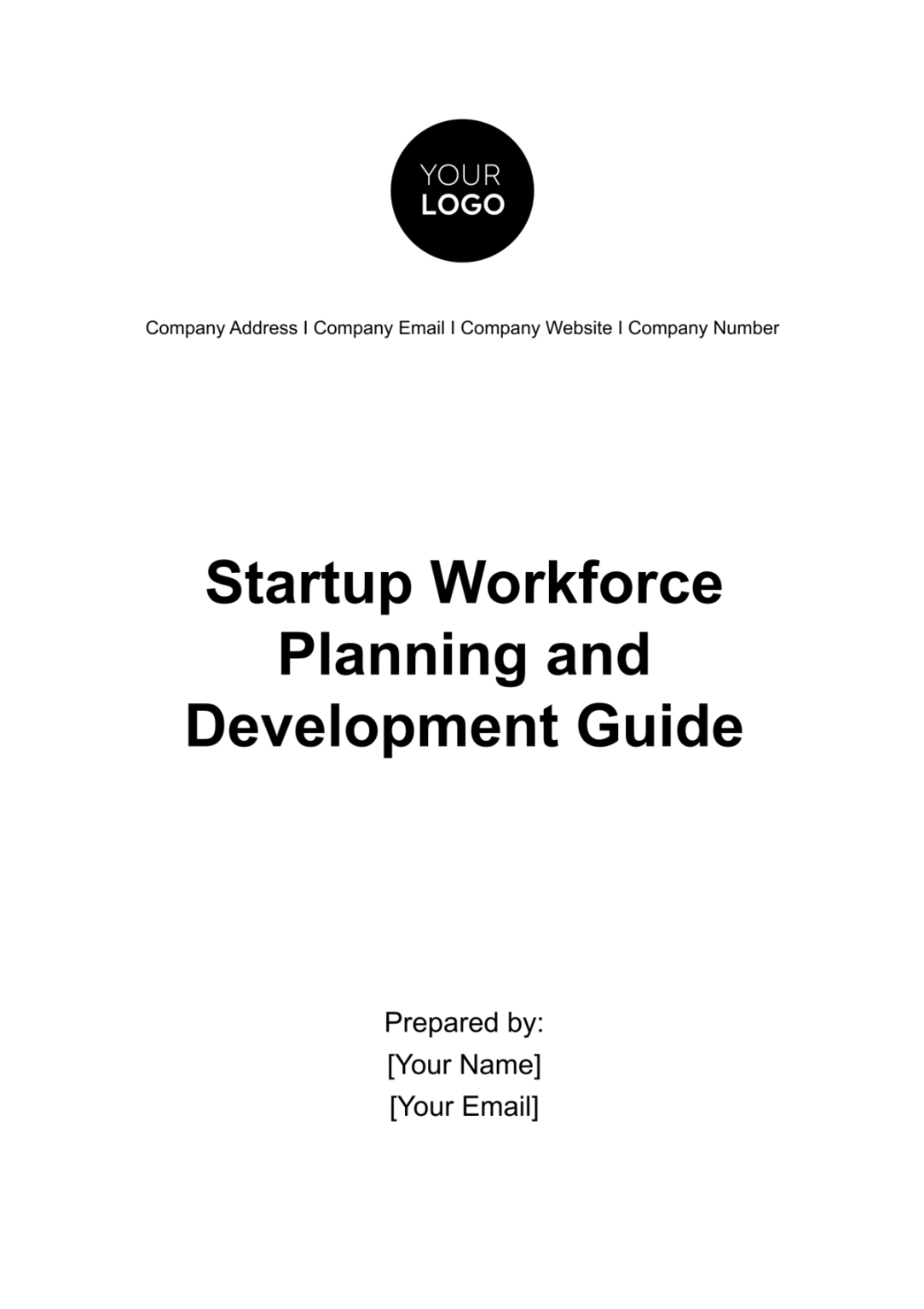
Welcome to the Startup Workforce Planning and Development Guide exclusively created to streamline your journey towards effective workforce planning and consistent professional development within your organization. This integrated approach will not only create a compelling narrative for your brand's unique identity but also ensure structured growth and sustainability.
Table of Contents
1. Assessing Workforce Needs
2. Recruitment Strategy
3. Training and Development
4. Succession Planning
5. Employee Engagement and Retention
6. Workforce Analytics
7. Compliance and Risk Management
1. Assessing Workforce Needs
In the competitive and fast-paced startup environment, strategic workforce planning is a critical determinant of success. This section outlines a meticulous approach for [Your Company Name] to align its human capital with the strategic objectives and evolving market demands. Through the identification of current and future business requirements, comprehensive gap analysis, and in-depth workforce demographics study, we lay the groundwork for a workforce adept at driving innovation and achieving sustainable growth.
Identify Current and Future Business Requirements
For [Your Company Name] to maintain its competitive edge and foster growth, it's imperative to thoroughly understand the required competencies and roles that align with both immediate objectives and long-term strategic goals. This entails a rigorous evaluation of the company's mission, market opportunities, and potential challenges to precisely determine the skill sets and positions essential for success. Establishing these criteria ensures that talent acquisition and development are strategically focused on propelling [Your Company Name] towards its envisioned future.
Business Objective | Required Competencies | Essential Roles | Timeframe |
|---|---|---|---|
Expand into new markets | Market analysis, Multilingual communication, Regulatory knowledge | Market Research Analyst, International Sales Manager | Short-term (1-2 years) |
Develop new tech products | Software development, AI and Machine Learning, Product management | Software Developer, AI Specialist, Product Manager | Long-term (3-5 years) |
Enhance customer experience | Customer service, Data analysis, UX/UI design | Customer Support Specialist, Data Analyst, UX/UI Designer | Ongoing |
Conducting a Gap Analysis
A detailed gap analysis is foundational in bridging the current state of [Your Company Name]'s workforce with its future aspirations. By contrasting the present capabilities, knowledge, and roles within the organization against those identified as necessary for future success, gaps in skills and positions can be accurately identified. This critical assessment informs targeted hiring, training, and professional development initiatives, ensuring the workforce's evolution is strategically aligned with the company’s growth and innovation trajectories.
Role/Competency | Current State | Future Needs | Gap Identified |
|---|---|---|---|
Software Developer | 5 Developers with focus on web development | Need 10 Developers with expertise in AI and Machine Learning | Shortage of 5 AI-focused Developers |
Market Research Analyst | 2 Analysts with domestic market expertise | Require 4 Analysts with international market knowledge | Need for 2 additional Analysts with international focus |
UX/UI Designer | 3 Designers with basic UX skills | Need 5 Designers with advanced UX/UI and interaction design skills | Shortage of 2 advanced skill UX/UI Designers |
Analyzing Workforce Demographics
A profound understanding of the demographic makeup of [Your Company Name]'s workforce is vital for fostering a culture of diversity, equity, and inclusion, which in turn drives creativity and resilience. Analyzing demographic data allows the company to anticipate retirement and succession planning needs, identify leadership potential, and set actionable diversity and inclusion goals. This strategic focus on demographics ensures [Your Company Name] not only mirrors the diversity of the global marketplace it operates in but also leverages varied perspectives for competitive advantage.
Demographic Factor | Current Composition | Future Goals | Strategic Actions |
|---|---|---|---|
Age Distribution | 60% under 30, 40% 30-50 | Maintain diversity with broader 30-50 representation | Implement mentorship programs to balance experience and innovation |
Gender Diversity | 70% Male, 30% Female in tech roles | Achieve a 50-50 gender balance in tech roles | Enhance recruitment strategies to attract more female tech talent |
Cultural Diversity | Predominantly local staff | Increase international staff representation to 30% | Target international talent in recruitment campaigns |
2. Recruitment Strategy
In today's highly competitive market, attracting and securing top talent is crucial for the sustained growth and innovation of [Your Company Name]. Our comprehensive recruitment strategy is designed to identify, attract, and onboard individuals who not only possess the requisite skills and expertise but also share our core values and vision. Through targeted talent sourcing, a rigorous selection process, and a robust onboarding program, we aim to build a workforce that is not only skilled but also deeply aligned with our company culture and long-term objectives.
Sourcing Talent
To ensure we attract candidates of the highest caliber, [Your Company Name] employs a multifaceted approach to talent sourcing. Leveraging the power of digital platforms such as LinkedIn, industry-specific job boards, and social media, we cast a wide net to reach diverse talent pools. Additionally, we actively participate in networking events and establish partnerships with leading colleges and universities, enabling us to connect with emerging talent who are eager to innovate and grow. This strategic mix of sourcing channels allows us to tap into a rich reservoir of potential candidates who are well-aligned with our company's ethos and future direction.
Sourcing Channel | Description | Target Audience |
|---|---|---|
Utilize for professional networking and job postings. | Experienced professionals | |
Industry-specific job boards | Post openings on platforms specific to our industry. | Skilled candidates in our field |
Social Media | Engage potential candidates through content and ads. | Young professionals and recent graduates |
Networking Events | Attend and host events to meet talent in person. | Local talent and industry professionals |
College Partnerships | Collaborate with institutions for internships and placements. | Emerging talent and interns |
Selection Process
At [Your Company Name], the selection process is meticulously designed to assess not only the technical abilities and professional qualifications of candidates but also their cultural fit within our organization. Our process begins with a thorough screening of applications, followed by structured interviews that incorporate behavioral and competency-based questions. We also employ practical assessments or projects where relevant, to gauge real-world skills and problem-solving capabilities. This comprehensive approach ensures that we select individuals who not only excel in their roles but also contribute positively to our company culture and team dynamics.
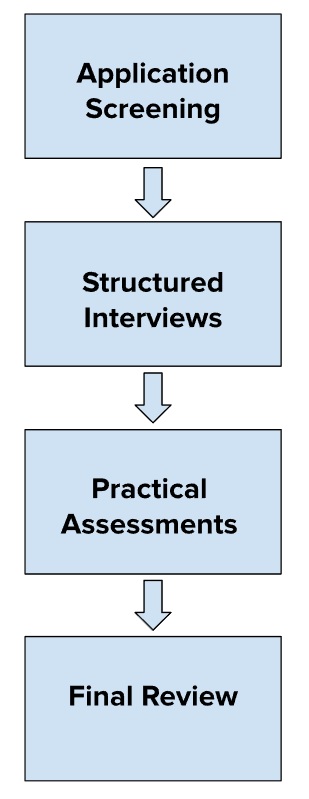
Stage | Method | Purpose |
|---|---|---|
Application Screening | Review resumes and cover letters. | To shortlist candidates based on qualifications and experience. |
Structured Interviews | Conduct behavioral and competency-based interviews. | To assess cultural fit and soft skills. |
Practical Assessments | Implement skill-specific tasks or projects. | To gauge practical abilities and problem-solving skills. |
Final Review | Panel discussion and candidate comparison. | To select the candidate who best aligns with role requirements and company culture. |
Onboarding Program
Recognizing the critical importance of the initial stages of employment, our onboarding program is carefully crafted to integrate new hires into [Your Company Name] seamlessly. The program covers essential aspects such as an introduction to our company culture, core values, and operational processes, alongside role-specific training and mentorship opportunities. By providing a supportive and informative onboarding experience, we aim to foster a sense of belonging and engagement from day one, setting the foundation for new employees to thrive and succeed within our organization.
Component | Description | Goal |
|---|---|---|
Culture Introduction | Overview of company values, mission, and history. | To align new hires with company ethos. |
Operational Training | Role-specific procedures and tools training. | To equip new hires with the necessary knowledge and skills. |
Mentorship Program | Assigning a mentor for guidance and support. | To facilitate integration and provide a go-to person for queries. |
Feedback Sessions | Regular check-ins during the first few months. | To address concerns, gather feedback, and adjust the onboarding experience if needed. |
3. Training and Development
At [Your Company Name], we understand that our employees are our greatest asset. As such, we are committed to their continuous growth and development. Through our comprehensive Training and Development programs, we aim to enhance their skills, foster leadership qualities, and align their personal goals with our corporate objectives. This multifaceted approach ensures not only the personal and professional growth of our team members but also the overall success and competitiveness of our company in the dynamic market landscape.
Skill Development Programs
In today’s fast-paced business environment, staying ahead requires a workforce that is adept and adaptable. [Your Company Name] has instituted robust skill development programs designed to address current skill gaps and prepare our team for future challenges. These programs, ranging from technical upskilling to soft skills enhancement, are tailored to promote internal mobility, ensuring our employees are well-equipped to take on new roles and responsibilities. By investing in our employees' continuous learning, we not only enhance their career paths but also ensure our company remains agile and innovative.
Program Type | Description | Target Audience | Outcome Expected |
|---|---|---|---|
Technical Upskilling | Specialized training in new technologies. | Tech Team | Enhanced technical capabilities, readiness for innovation projects. |
Soft Skills Enhancement | Workshops on communication, teamwork, and problem-solving. | All Employees | Improved collaboration, conflict resolution, and customer interaction. |
Cross-functional Training | Opportunities to learn about different departmental functions. | Interested Employees | Increased internal mobility, broader understanding of company operations. |
Leadership Development
Recognizing the critical role of strong leadership in achieving business success, [Your Company Name] places a high priority on cultivating the next generation of leaders within our organization. Our leadership development initiatives are structured to identify and nurture high-potential employees, providing them with the training and experiences necessary to excel in managerial and executive roles. Through workshops, mentorship programs, and leadership challenges, we aim to equip our future leaders with the skills required for effective team and project management, decision-making, and strategic planning.
Initiative | Description | Target Audience | Outcome Expected |
|---|---|---|---|
Leadership Workshops | Interactive sessions on leadership principles. | High-potential Employees | Development of leadership competencies, readiness for management roles. |
Mentorship Program | One-on-one guidance from experienced leaders. | Aspiring Leaders | Personalized development, insights into effective leadership practices. |
Leadership Challenges | Real-world projects to test and refine leadership skills. | Emerging Leaders | Practical leadership experience, decision-making, and strategic thinking enhancement. |
Performance Management
A robust performance management system is pivotal to aligning individual employee goals with the broader objectives of [Your Company Name]. Our system is designed to facilitate ongoing communication between employees and their managers, setting clear expectations, providing regular feedback, and conducting comprehensive appraisals. This process not only helps in recognizing and rewarding high performance but also identifies areas for improvement, ensuring employees are continuously supported in their professional development journey. Through this structured performance management approach, we foster a culture of excellence and accountability across the organization.
Component | Description | Process | Outcome Expected |
|---|---|---|---|
Goal Setting | Aligning individual goals with company objectives. | Annual goal-setting meetings. | Clear direction, motivated employees. |
Regular Feedback | Ongoing communication on performance. | Quarterly reviews, real-time feedback. | Continuous improvement, engagement. |
Comprehensive Appraisals | Evaluating performance over a specific period. | Annual performance reviews. | Recognition of achievements, identification of development areas. |
4. Succession Planning
Succession planning is a strategic imperative at [Your Company Name], ensuring the sustainability and continuity of leadership and critical roles within our organization. This section delves into the identification of key positions requiring succession plans, the development of a robust talent pool, and the formulation of detailed transition plans. By proactively addressing these areas, we secure our company's future leadership and safeguard against potential disruptions in our operations and strategic execution.
Critical Role Identification
In the dynamic landscape of [Your Company Name], recognizing and prioritizing critical roles is the first step in our succession planning process. We conduct a thorough analysis of our organizational structure to determine positions essential for our operational and strategic success. This involves evaluating the impact of each role on our business continuity, the unique skills required, and the difficulty of replacing these positions. By identifying these critical roles, we can strategically focus our succession efforts to ensure that no key function is left vulnerable due to unforeseen departures or changes.
Role Title | Department | Impact on Business Continuity | Skills Required | Replacement Difficulty |
|---|---|---|---|---|
Chief Technology Officer | Technology | High | Leadership, Technical Expertise, Strategic Planning | Very High |
Director of Operations | Operations | High | Process Optimization, Leadership, Operational Excellence | High |
Head of Product Development | Product Development | High | Innovation, Product Management, Market Analysis | High |
Talent Pool Development
At the heart of our succession strategy is the cultivation of a talent pool composed of high-potential employees who exhibit the skills, leadership potential, and organizational fit to ascend into critical roles. Through targeted development programs, mentorship opportunities, and rotational assignments, we actively invest in preparing these individuals for future leadership positions. This not only aids in retaining top talent but also ensures that [Your Company Name] has a ready reserve of capable leaders to drive our future growth and innovation.
Development Initiative | Target Audience | Objective | Key Activities |
|---|---|---|---|
Leadership Training Program | High-potential Employees | To prepare employees for future leadership roles | Workshops, Leadership Challenges |
Mentorship Program | Aspiring Leaders | To provide guidance and accelerate development | One-on-one mentorship, Shadowing |
Cross-functional Rotations | Employees with Leadership Potential | To broaden skill sets and organizational understanding | Rotational Assignments in Different Departments |
Transition Plans
Effective succession planning culminates in the creation of comprehensive transition plans for each identified critical role. These plans detail the process for handing over responsibilities, including specific timelines, necessary training sessions, and knowledge transfer methodologies. By meticulously outlining these steps, we aim to facilitate seamless leadership transitions, minimizing any potential impact on our operations. Transition plans are regularly reviewed and updated to reflect changes in our organizational needs and the evolving capabilities of our talent pool, ensuring ongoing relevance and effectiveness.
Critical Role | Transition Timeline | Training Requirements | Knowledge Transfer Methods | Review Frequency |
|---|---|---|---|---|
Chief Technology Officer | 6 Months | Strategic Leadership, Tech Trends | Documentation Review, Shadowing | Annually |
Director of Operations | 3 Months | Operational Efficiency, Leadership | Process Workshops, Meeting Observations | Bi-Annually |
Head of Product Development | 4 Months | Market Analysis, Product Lifecycle Management | Project Handover, Strategy Sessions | Annually |
5. Employee Engagement and Retention
At [Your Company Name], we understand that our employees are the cornerstone of our success. Therefore, fostering a vibrant work culture, recognizing and rewarding contributions, and providing clear avenues for career progression are pivotal aspects of our employee engagement and retention strategy. This comprehensive approach ensures a motivated workforce, driving innovation, productivity, and long-term loyalty to our company. By prioritizing these key areas, we aim to not only retain top talent but also attract the best in the industry.
Work Culture Enhancement
Creating an enriching work environment where collaboration, innovation, and open communication are the norms forms the bedrock of [Your Company Name]'s culture. We strive to build a workspace where creativity is nurtured, ideas are freely exchanged, and teamwork is celebrated. Regular team-building activities, open forums for idea sharing, and leadership transparency are practices we've instituted to strengthen our company culture. This environment not only enhances employee satisfaction and productivity but also makes [Your Company Name] a coveted place to work.
Initiative | Description | Expected Outcome |
|---|---|---|
Team-Building Activities | Organize monthly team outings and creative workshops. | Enhance teamwork and interpersonal connections. |
Open Idea Forums | Hold quarterly forums for employees to pitch ideas directly to management. | Foster innovation and open communication. |
Leadership Transparency | Implement a monthly "Open Door" day with executives. | Build trust and encourage direct feedback. |
Reward and Recognition Programs
Acknowledging and incentivizing our employees' hard work and achievements is fundamental to our ethos at [Your Company Name]. Our comprehensive reward system includes performance bonuses, employee of the month awards, and recognition at company-wide meetings, alongside non-monetary accolades such as additional time off and public acknowledgment of success. By implementing these programs, we aim to cultivate a culture of appreciation and motivation, encouraging our team members to continuously strive for excellence and innovation in their roles.
Program | Description | Recognition Frequency |
|---|---|---|
Performance Bonuses | Financial bonuses based on individual and team achievements. | Annually and semi-annually |
Employee of the Month | Award recognizing outstanding contribution with perks. | Monthly |
Public Acknowledgments | Highlighting achievements in company-wide meetings and newsletters. | As achievements occur |
Career Pathways
At [Your Company Name], we are committed to the professional growth and advancement of our employees. We've developed clear career pathways that outline progression opportunities within the organization, supported by professional development programs, mentorship, and regular performance evaluations. These pathways provide employees with a transparent and achievable roadmap to advance their careers, aligning their personal growth ambitions with the company's strategic goals. This not only aids in retaining talent but also in fostering a highly skilled and ambitious workforce.
Pathway Element | Description | Implementation Method |
|---|---|---|
Professional Development Programs | Structured training and courses for skill advancement. | Through internal L&D initiatives and external courses. |
Mentorship Program | Pairing employees with experienced mentors within the company. | Matching based on career interests and expertise areas. |
Performance Evaluations | Regular reviews to assess progress and identify growth opportunities. | Bi-annual performance review meetings with direct supervisors. |
6. Workforce Analytics
In the era of data-driven decision-making, [Your Company Name] leverages workforce analytics to sculpt a high-performing and efficient team. Through meticulous data collection, insightful analysis and reporting, and a commitment to continuous improvement, we harness the power of analytics to enhance workforce planning, performance, and development. This strategic approach enables us to not only meet but anticipate the evolving needs of our organization, ensuring our workforce remains agile, motivated, and aligned with our business objectives.
Data Collection
At [Your Company Name], we've instituted sophisticated systems to meticulously gather data encompassing workforce demographics, performance metrics, and outcomes of training programs. This initiative facilitates the capture of a broad spectrum of data points — from age, gender, and tenure to individual and team performance indicators, and the efficacy of professional development efforts. By establishing a rich database, we lay the groundwork for informed analysis, enabling us to identify patterns and correlations that influence workforce dynamics and organizational performance.
Data Category | Data Points | Collection Method |
|---|---|---|
Workforce Demographics | Age, Gender, Tenure, Department | HR Information System (HRIS) |
Performance Metrics | Sales numbers, Project completion rates, Customer satisfaction scores | Performance management software, Customer feedback tools |
Training Outcomes | Course completion rates, Post-training assessment scores, Application of skills in projects | Learning Management System (LMS), Supervisor evaluations |
Analysis and Reporting
Leveraging the comprehensive data collected, our analysts employ advanced statistical methods and analytics tools to dissect and understand trends, variances, and potential areas for optimization. This process illuminates key insights into workforce efficiency, engagement levels, and skill gaps, among other critical metrics. Regular reporting to stakeholders ensures transparency and supports strategic decision-making, with data-driven insights guiding the refinement of recruitment, development, and retention strategies to better align with organizational goals.
Analysis Focus | Tools Used | Reporting Frequency | Key Stakeholders |
|---|---|---|---|
Trend Analysis | Statistical software, AI analytics platforms | Quarterly | Department heads, Executive team |
Skill Gap Identification | HRIS, LMS, Internal surveys | Bi-annually | HR department, Training coordinators |
Engagement Levels | Employee engagement surveys, Social network analysis tools | Annually | All employees, Management team |
Continuous Improvement
The cornerstone of our workforce analytics initiative is the commitment to continuous improvement. Insights derived from data analysis are not merely observed but actively applied to refine and enhance workforce strategies and interventions. Whether adjusting recruitment tactics, tailoring training programs, or modifying performance management frameworks, the goal is perpetual advancement. This cyclical process of analysis, implementation, and reevaluation fosters an environment of constant growth and adaptation, ensuring [Your Company Name]'s workforce strategies remain cutting-edge and effective.
Improvement Area | Insights Applied | Evaluation Method | Review Cycle |
|---|---|---|---|
Recruitment Strategies | Adjusting sourcing channels based on performance metrics | Candidate quality and retention rates | After each recruitment cycle |
Training Programs | Tailoring content based on skill gap analysis | Post-training assessments, Project performance | Annually |
Performance Management | Modifying frameworks based on engagement and efficiency metrics | Performance reviews, Employee feedback | Bi-annually |
7. Compliance and Risk Management
At [Your Company Name], we prioritize the integrity and safety of our workforce by rigorously adhering to compliance and risk management practices. This section underscores our commitment to regulatory compliance, proactive risk assessment, and the formulation of robust mitigation strategies. By embedding these principles into our operational framework, we not only protect our company from potential liabilities but also foster a secure and equitable work environment. Our approach ensures that [Your Company Name] remains a responsible and law-abiding employer, prepared to navigate the complexities of workforce management in today’s dynamic business environment.
Regulatory Compliance
[Your Company Name] maintains a strict adherence to all applicable labor laws and regulations to ensure a fair and safe working environment. Our compliance strategy includes regular updates and training on equal employment opportunities, health and safety standards, and wage requirements. We conduct internal audits and engage with legal experts to stay abreast of legislative changes, ensuring our policies and practices meet or exceed legal standards. This commitment to compliance not only safeguards our employees but also reinforces our company’s reputation as an ethical and responsible employer.
Compliance Area | Activity Description | Frequency | Monitoring Method |
|---|---|---|---|
Labor Laws | Review and update policies to align with current labor laws. | Annually | Internal audits, Legal consultations |
Health and Safety | Conduct safety training and emergency drills. | Bi-annually | Safety audits, Employee feedback |
Wage Standards | Regularly update payroll to comply with minimum wage adjustments. | As needed | Payroll audits, Compliance software |
Equal Employment Opportunities | Implement diversity and inclusion training. | Annually | HR reviews, Employee surveys |
Risk Assessment
In the fluid landscape of workforce management, [Your Company Name] employs a systematic approach to risk assessment, identifying potential challenges related to skills shortages, employee turnover, and legal adherence. By leveraging data analytics and engaging with department heads, we continuously evaluate risks that could impact our operational efficiency and legal standing. This ongoing assessment allows us to anticipate issues before they escalate, enabling proactive measures to safeguard our organizational health and employee satisfaction.
Risk Category | Risk Identification Process | Evaluation Frequency | Tools Used |
|---|---|---|---|
Skills Shortages | Analyze workforce skills and future project requirements. | Quarterly | HRIS, Skills assessment tools |
Employee Turnover | Monitor turnover rates and exit interview data. | Monthly | Analytics software, Surveys |
Legal Compliance | Regular review of policies against legal changes. | Annually | Compliance checklists, Legal advisories |
Mitigation Strategies
Understanding that risk identification is only the first step, [Your Company Name] has developed comprehensive mitigation strategies to address potential workforce challenges. These strategies range from enhancing recruitment processes to minimize skills gaps, implementing retention programs to reduce turnover, and conducting regular compliance training to ensure legal adherence. Our mitigation efforts are tailored to the unique needs and risks of our organization, ensuring that we are well-equipped to manage and overcome challenges, thereby securing the long-term success and stability of our workforce.
Risk Category | Strategy | Implementation Steps | Outcome Measurement |
|---|---|---|---|
Skills Shortages | Enhance recruitment and development programs. | Identify skills gaps, Tailor training programs. | Reduction in skills gap, Improved project performance |
Employee Turnover | Implement retention programs and career pathways. | Develop career plans, Increase engagement initiatives. | Lower turnover rates, Higher employee satisfaction |
Legal Compliance | Conduct regular compliance training and audits. | Schedule training sessions, Perform annual audits. | No legal violations, Positive audit outcomes |
- 100% Customizable, free editor
- Access 1 Million+ Templates, photo’s & graphics
- Download or share as a template
- Click and replace photos, graphics, text, backgrounds
- Resize, crop, AI write & more
- Access advanced editor
Leverage your startup's potential with Template.net's Startup Workforce Planning and Development Guide Template. This editable, customizable template, editable in our Ai Editor Tool, simplifies workforce management. Don't let growth opportunities slip by due to poor planning. Increase efficiency, and adopt a systematized approach to human resource development with this essential tool. Encourage your team's progression while remaining focused on your business goals. Trust Template.net and elevate your startup's success.
You may also like
- Startup Agreement
- Non Profit
- Transport and Logistics
- Education
- IT Services and Consulting
- Startup Presentation
- Startup Business Plan
- Startup Proposal
- Startup Plan
- Startup Brochure
- Startup Form
- Startup Flyer
- Startup Checklist
- Startup Budget
- Startup Poster
- Startup Contract
- Startup Invoice
- Startup Letterhead
- Startup Quotes
